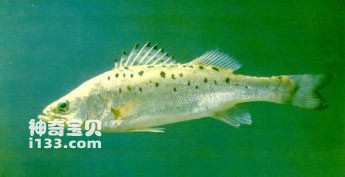Lateolabrax japonicus belongs to the order Perciformes, family Japonicidae, and genus Lateolabrax japonicus. Commonly known as: Perch, Huazhai, Perch, Perch Board. English name: Japanese sea perch, Black spotfed bass.
The body is long, flat on the sides, and both dorsal and ventral surfaces are blunt and rounded; the head is medium-large and slightly pointed. The snout is pointed, the mouth is large, terminal, and cleft obliquely, and the upper jaw extends below the posterior edge of the eye. Both jaws, vomer and oral bones have small teeth. The posterior edge of the anterior gill bone has fine serrations, there are 3 large spines on the lower edge of the posterior horn, and the posterior end of the posterior operculum has 1 spine. The scales are small and the lateral lines are complete and straight. There are two dorsal fins, connected only at the base. The first dorsal fin has 12 hard spines, and the second dorsal fin has 1 hard spine and 11-13 soft rays. The back of the body is gray, and the sides and abdomen are silver-gray. There are black spots on the upper part of the body and dorsal fin, and the spots decrease with age.

Bass likes to live in brackish water at estuaries, and can also live in fresh water. It mainly swims in the middle and lower layers of the water, and sometimes dives to the bottom to look for food. The fry feed on zooplankton, the juveniles feed on shrimps, and the adults feed on fish. Sexually mature broodstock are generally 3-year-old individuals with a body length of about 600 mm. The reproductive season is in late autumn, and the spawning ground is in the brackish water area of the estuary.
Distributed in China, North Korea and Japan in East Asia, this fish is found in fresh water bodies along my country's coast and in the sea.
Bass grows rapidly and is large, generally weighing 1.5-2.5 kilograms, and the largest individual can reach more than 15 kilograms. Its meat is delicious. Ancient poets once praised its body and taste with the poem "People come and go on the river, but they love the beauty of sea bass". In coastal areas, the yield is higher and it is one of the important edible fish in the production area. Its meat contains 17.5 grams of protein, 3.1 grams of fat, 0.4 grams of carbohydrates, 100 kcal of calories, 56 mg of calcium, 131 mg of phosphorus, 1.2 mg of iron, 0.23 mg of vitamin B2, 1.7 mg of niacin and trace amounts of vitamin B1 per 100 grams. .
The gills and meat of seabass can be used as medicine. Its gills are sweet and flat in nature, have the effect of relieving cough and reducing phlegm, and can be used to treat whooping cough in children. Its meat is sweet and warm in nature and has the effect of strengthening the spleen and replenishing qi. It is often used to treat chronic stomach pain, spleen deficiency and diarrhea, infantile malnutrition, indigestion, weight loss and other diseases. If eaten after surgery, it can also promote wound healing.
animal tags:
We created this article in conjunction with AI technology, then made sure it was fact-checked and edited by a Animals Top editor.